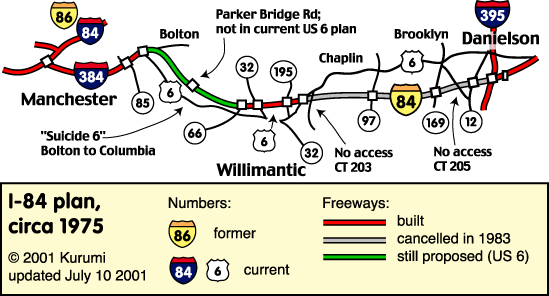Who owns all the I-384 ROW? That's my hangup: NIMBY/Encroachment. Won't the same forces that stopped I-384 stop anything else?
No. The last I-384 routing and attempt at fed funding in 2003 gained approval from the locals at long last. It was a 4-lane highway with avg. 1000 ft. greenway median for environmental protection and sound deadening taking a north-of-Hop River routing with no exits except possibly one in Andover near Routes 6 and CT87 (undecided). Most of it is woods that are either state-owned conservation property, bought or eminent domained eons ago for I-84 by the state, or are one of those quirky 18th century land-deed things where some old Yankee family has owned a patch of re-forested farmland for 200 years and gets some grandfathered tax break if they just don't build on it. Very few private property takings, which was the whole point at gaining approval. There is a whole lot of nothing near the Hop River.
It got spiked by the Army Corps who said it would only endorse the south-of-Hop River routing that required the most houses to be bulldozed of any of the alternatives under consideration. Gave environmental protection reasons, but no compelling justification for them. It was most likely a South Coast Rail-esque political power play to force them to do business on the Army Corp's terms so the right people got the busywork. Fast-track fed funding application was withdrawn due to the impasse, and that to-date has been the end of it.
Willimantic-Plainfield was never all that controversial, even 50 years ago. Pretty much still this:
None of that, of course, matters until you have a contiguous highway to Willimantic.
They can dust off this Willimantic plan again and if the Army Corps doesn't play politics again they probably get approval on the route the locals agreed to. Building the rail line in the median may be an extra feather in the cap because while it will claim a few feet of greenway the reduction in truck traffic from Worcester-Hartford double-stack intermodal freight and commuter rail Hartford-New London will be an aggregate net-gain for pollution and traffic reduction.
Wouldn't have to wait for the other pieces of the HSR bypass to make optimal use of it either.
-- Connect to Willimantic and NECR's mainline offers direct access to New London and Mohegan Sun for diesel commuter rail out of Hartford.
-- Freight already moves between P&W and NECR Worcester-Plainfield-Willimantic on the P&W mainline and Willimantic Secondary. Hartford intermodal can begin immediately, and P&W can take its dailies to New Haven off the crowded Shoreline.
-- Can operate diesel before electrifying, and Class 4/80 MPH track standards before upgrading the maintenance class to the Class 8/150 MPH the ROW would support for HSR. On all-diesel a Hartford-Willimantic-Plainfield-Worcester train probably would not beat an Inland through Springfield, but might be adequate enough for commuter/regional rail between the cities.
-- Northeast Regionals will have dual-mode locomotives at their disposal in probably another 8-10 years when Amtrak replaces its 3rd rail shoe Empire fleet with pantograph duals equally capable on- and off-wire. You will quite likely see these things on the Virginia and Springfield Regionals. So 125 MPH trains can cover the diesel gaps if you're doing slow-rolling upgrades. And eventually if New Haven-Willimantic and Worcester-Boston are up-to-snuff under wires the diesel gap through the slow legacy track will begin to handily beat the Springfield Inlands and become the preferred Hartford/Worcester-serving route from D.C. to Boston.
-- Plainfield-Providence can be built before the Willimantic-Plainfield highway + HSR extension if you likewise don't mind putting with the slow-speed gap on the Willimantic Sec. for a few years. This can open up Providence sooner to Hartford-Providence regional rail and 125 MPH Northeast Regionals that beat the Shoreline's slow-ass total travel time between New Haven and Providence.
-- Complete route when you fill in the last clean-roomed highway + HSR gap and get off the Willimantic Sec.
-- Speed increases on P&W to get a more even 90 MPH (diesel). Some grade crossing eliminations needed (Webster and Oxford in MA, especially), maybe some minor curve-straightening. Electrification expensive because 23'1" under-bridge clearance needed for double-stack freights to pass under wires. But unless the future Acelas are going to need this Worcester fork in large numbers you can get by with a dual-mode NE Regional doing 90 in the diesel gap between Plainfield and Worcester and 110-125 everywhere else for a lot of years before there's any compelling urgency to upgrade here.



